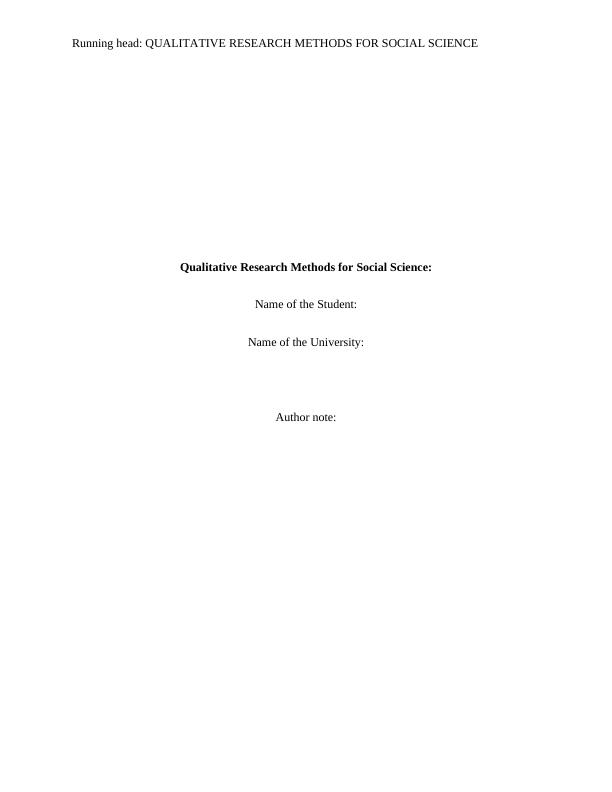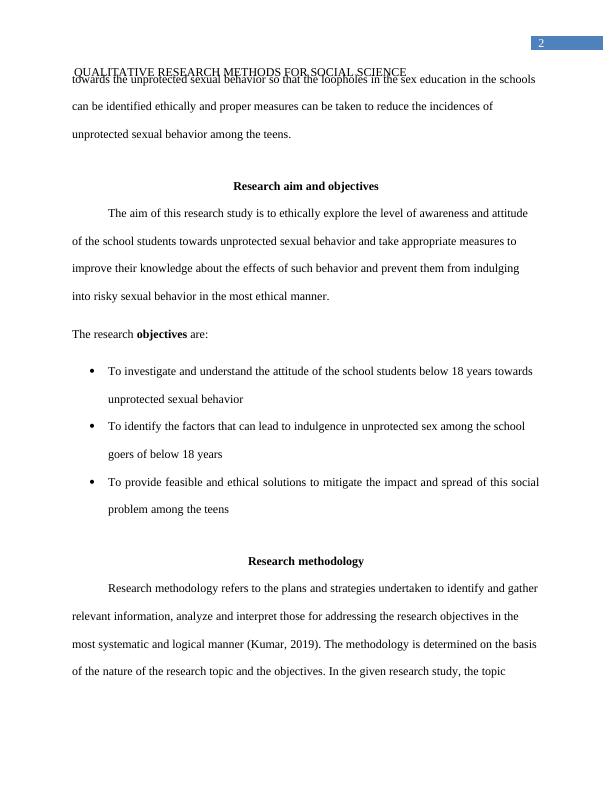Qualitative Research Methods for Social Science
Added on 2022-08-19
10 Pages2383 Words12 Views
Running head: QUALITATIVE RESEARCH METHODS FOR SOCIAL SCIENCE
Qualitative Research Methods for Social Science:
Name of the Student:
Name of the University:
Author note:
Qualitative Research Methods for Social Science:
Name of the Student:
Name of the University:
Author note:

1
QUALITATIVE RESEARCH METHODS FOR SOCIAL SCIENCE
Research proposal on ‘Determining the attitudes of the classmates towards unprotected
sexual behaviors’
Introduction
Unprotected sexual behavior is a major social issue among the teens in the first world
countries. This is also known as risky sexual behavior. Not only the teens, but a high percentage
of adults also indulge in unprotected sexual behavior which leads to various types of Sexually
Transmitted Diseases (STDs), Human Immunodeficiency Virus (HIV) infection and Acquired
Immunodeficiency Syndrome (AIDS). Among the teens, it has been observed that lack of proper
knowledge and awareness are the primary reasons that lead to sexual risk behaviors (Yoon,
Voith & Kobulsky, 2018). The adolescence is the time where children grow up, their hormone
level changes, and with greater exposure to internet and media, they grow curious about their
own body and their sexual orientation as well as desires. Hence, while having fun, the teens often
get involved in unprotected sexual behavior. According to the data of the Centers for Disease
Control and Prevention, around one in every four teens in the USA contracts a STD and almost
one million women under the age of 20 years get pregnant each year (CRC Health Group, 2019).
These information clearly indicate that a large number of teens engage in risky sexual behavior.
Studies have also shown that various reasons lead to the risky sexual behavior among the teens,
such as, the belief that use of protection or condom decrease the sexual pleasure, their fear that
their partner would disapprove the use of protection, increased use of alcohol and drugs, lack of
knowledge and education about protection and abstinence, proper parental guidance about the
sexuality and lack of awareness about the effects of the unprotected sex such as unwanted teen
pregnancy, STDs, HIV and AIDS are some of those (Dupas, Huillery & Seban, 2018). Hence, it
is crucial to conduct a social research to get an idea about the attitude of the school students
QUALITATIVE RESEARCH METHODS FOR SOCIAL SCIENCE
Research proposal on ‘Determining the attitudes of the classmates towards unprotected
sexual behaviors’
Introduction
Unprotected sexual behavior is a major social issue among the teens in the first world
countries. This is also known as risky sexual behavior. Not only the teens, but a high percentage
of adults also indulge in unprotected sexual behavior which leads to various types of Sexually
Transmitted Diseases (STDs), Human Immunodeficiency Virus (HIV) infection and Acquired
Immunodeficiency Syndrome (AIDS). Among the teens, it has been observed that lack of proper
knowledge and awareness are the primary reasons that lead to sexual risk behaviors (Yoon,
Voith & Kobulsky, 2018). The adolescence is the time where children grow up, their hormone
level changes, and with greater exposure to internet and media, they grow curious about their
own body and their sexual orientation as well as desires. Hence, while having fun, the teens often
get involved in unprotected sexual behavior. According to the data of the Centers for Disease
Control and Prevention, around one in every four teens in the USA contracts a STD and almost
one million women under the age of 20 years get pregnant each year (CRC Health Group, 2019).
These information clearly indicate that a large number of teens engage in risky sexual behavior.
Studies have also shown that various reasons lead to the risky sexual behavior among the teens,
such as, the belief that use of protection or condom decrease the sexual pleasure, their fear that
their partner would disapprove the use of protection, increased use of alcohol and drugs, lack of
knowledge and education about protection and abstinence, proper parental guidance about the
sexuality and lack of awareness about the effects of the unprotected sex such as unwanted teen
pregnancy, STDs, HIV and AIDS are some of those (Dupas, Huillery & Seban, 2018). Hence, it
is crucial to conduct a social research to get an idea about the attitude of the school students

2
QUALITATIVE RESEARCH METHODS FOR SOCIAL SCIENCE
towards the unprotected sexual behavior so that the loopholes in the sex education in the schools
can be identified ethically and proper measures can be taken to reduce the incidences of
unprotected sexual behavior among the teens.
Research aim and objectives
The aim of this research study is to ethically explore the level of awareness and attitude
of the school students towards unprotected sexual behavior and take appropriate measures to
improve their knowledge about the effects of such behavior and prevent them from indulging
into risky sexual behavior in the most ethical manner.
The research objectives are:
To investigate and understand the attitude of the school students below 18 years towards
unprotected sexual behavior
To identify the factors that can lead to indulgence in unprotected sex among the school
goers of below 18 years
To provide feasible and ethical solutions to mitigate the impact and spread of this social
problem among the teens
Research methodology
Research methodology refers to the plans and strategies undertaken to identify and gather
relevant information, analyze and interpret those for addressing the research objectives in the
most systematic and logical manner (Kumar, 2019). The methodology is determined on the basis
of the nature of the research topic and the objectives. In the given research study, the topic
QUALITATIVE RESEARCH METHODS FOR SOCIAL SCIENCE
towards the unprotected sexual behavior so that the loopholes in the sex education in the schools
can be identified ethically and proper measures can be taken to reduce the incidences of
unprotected sexual behavior among the teens.
Research aim and objectives
The aim of this research study is to ethically explore the level of awareness and attitude
of the school students towards unprotected sexual behavior and take appropriate measures to
improve their knowledge about the effects of such behavior and prevent them from indulging
into risky sexual behavior in the most ethical manner.
The research objectives are:
To investigate and understand the attitude of the school students below 18 years towards
unprotected sexual behavior
To identify the factors that can lead to indulgence in unprotected sex among the school
goers of below 18 years
To provide feasible and ethical solutions to mitigate the impact and spread of this social
problem among the teens
Research methodology
Research methodology refers to the plans and strategies undertaken to identify and gather
relevant information, analyze and interpret those for addressing the research objectives in the
most systematic and logical manner (Kumar, 2019). The methodology is determined on the basis
of the nature of the research topic and the objectives. In the given research study, the topic

End of preview
Want to access all the pages? Upload your documents or become a member.
Related Documents
Sexual Safety: Importance, Measures, and Role of Nurseslg...
|12
|836
|482
QUALITATIVE RESEARCH METHODS FOR SOCIAL SCIENCElg...
|9
|2133
|12
Analysis of Community Outbreak of HIV/AIDSlg...
|5
|802
|466
Education, HIV, and Early Fertilitylg...
|7
|1490
|222
Challenges Faced by Pregnant Teenagers: Two Studies and Their Recommendationslg...
|5
|1366
|418
Distribution of Condoms to Public High School Studentslg...
|8
|1911
|281